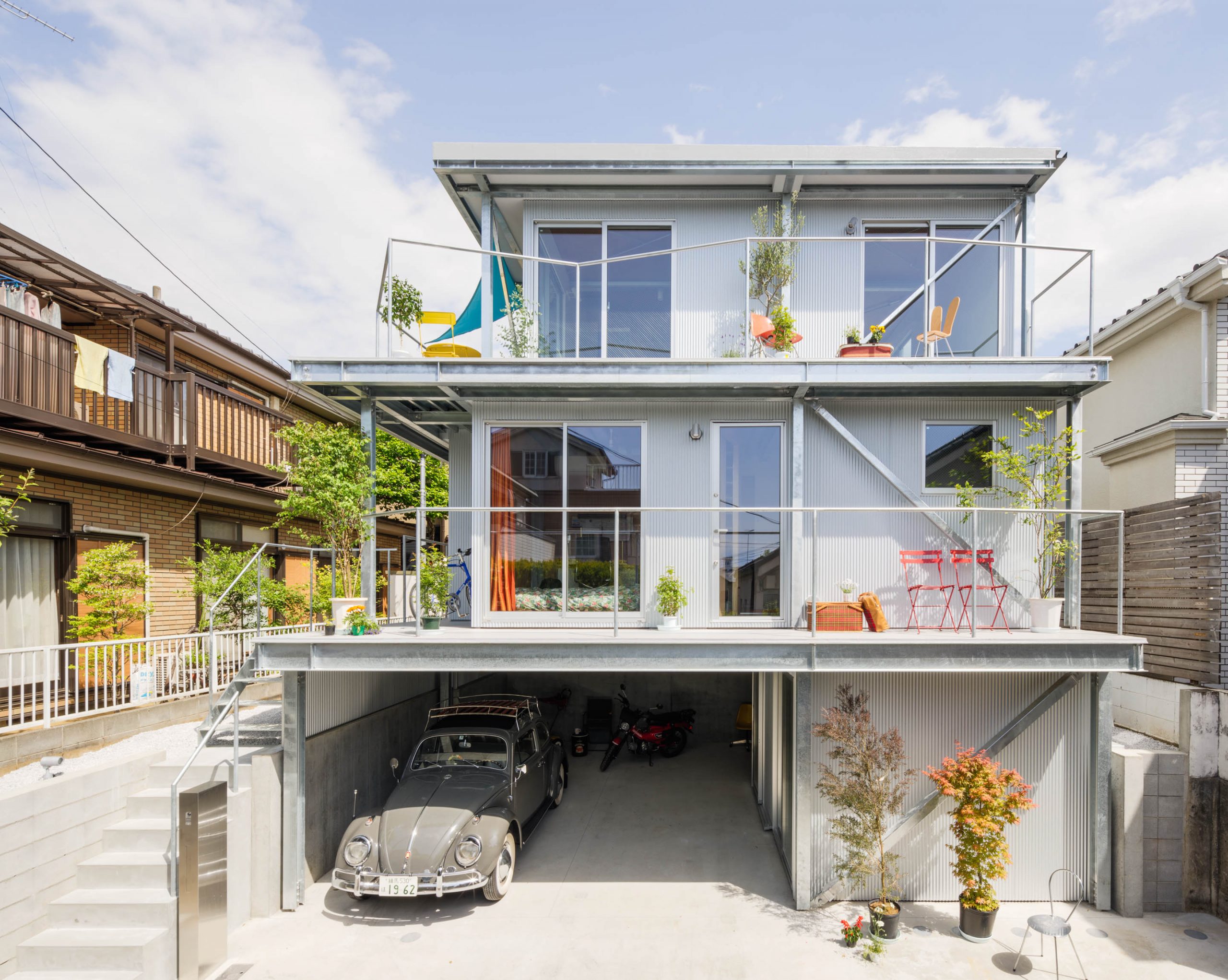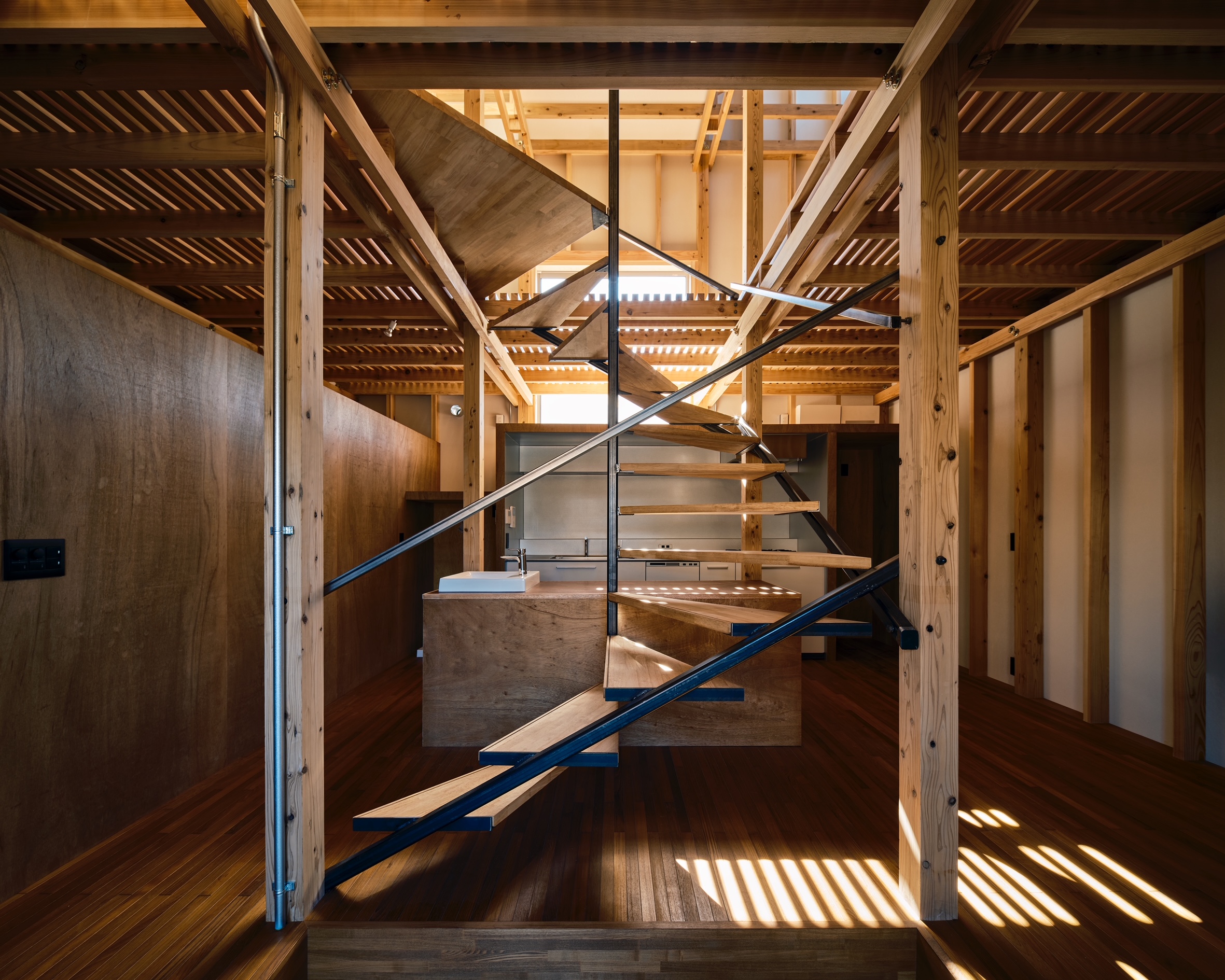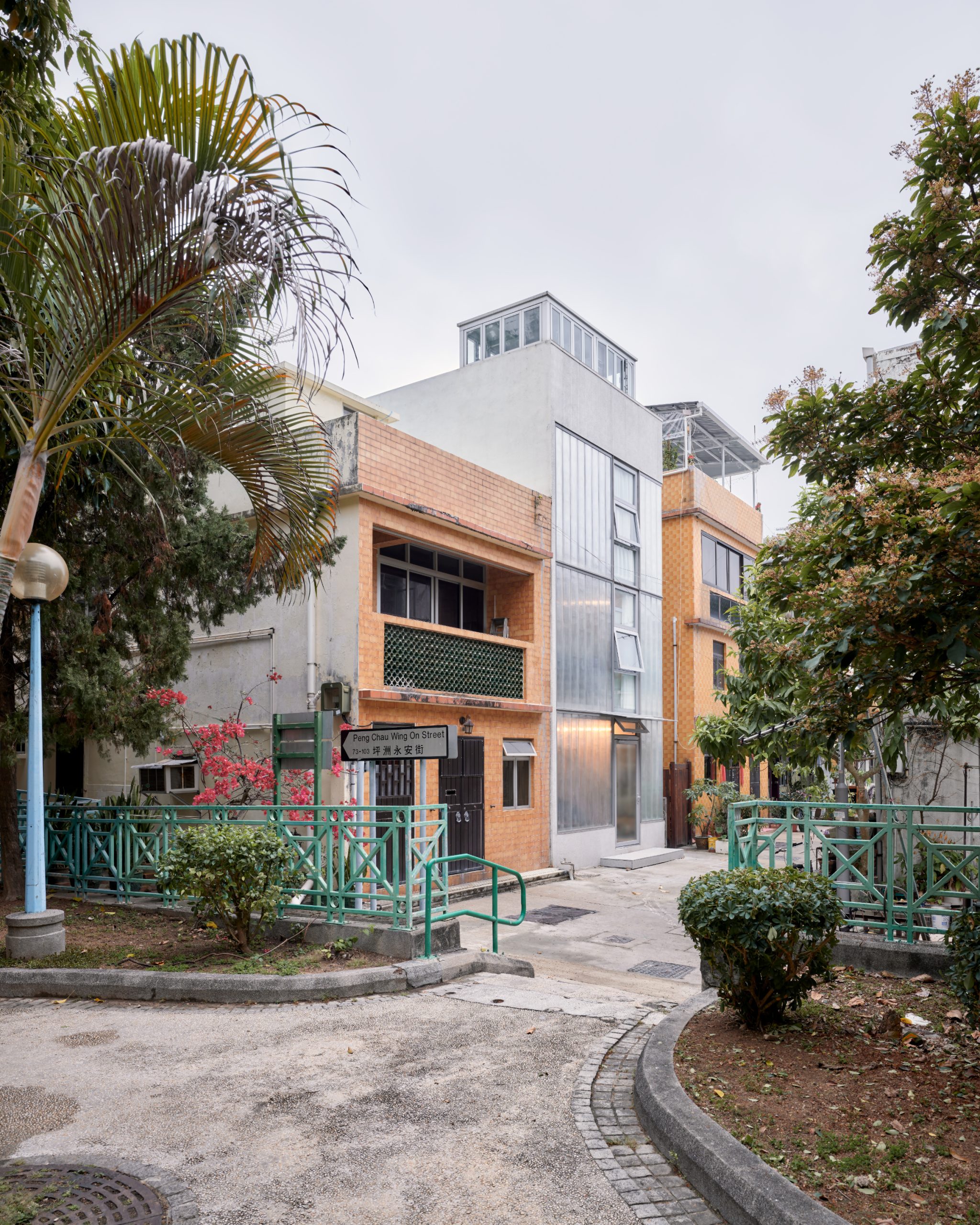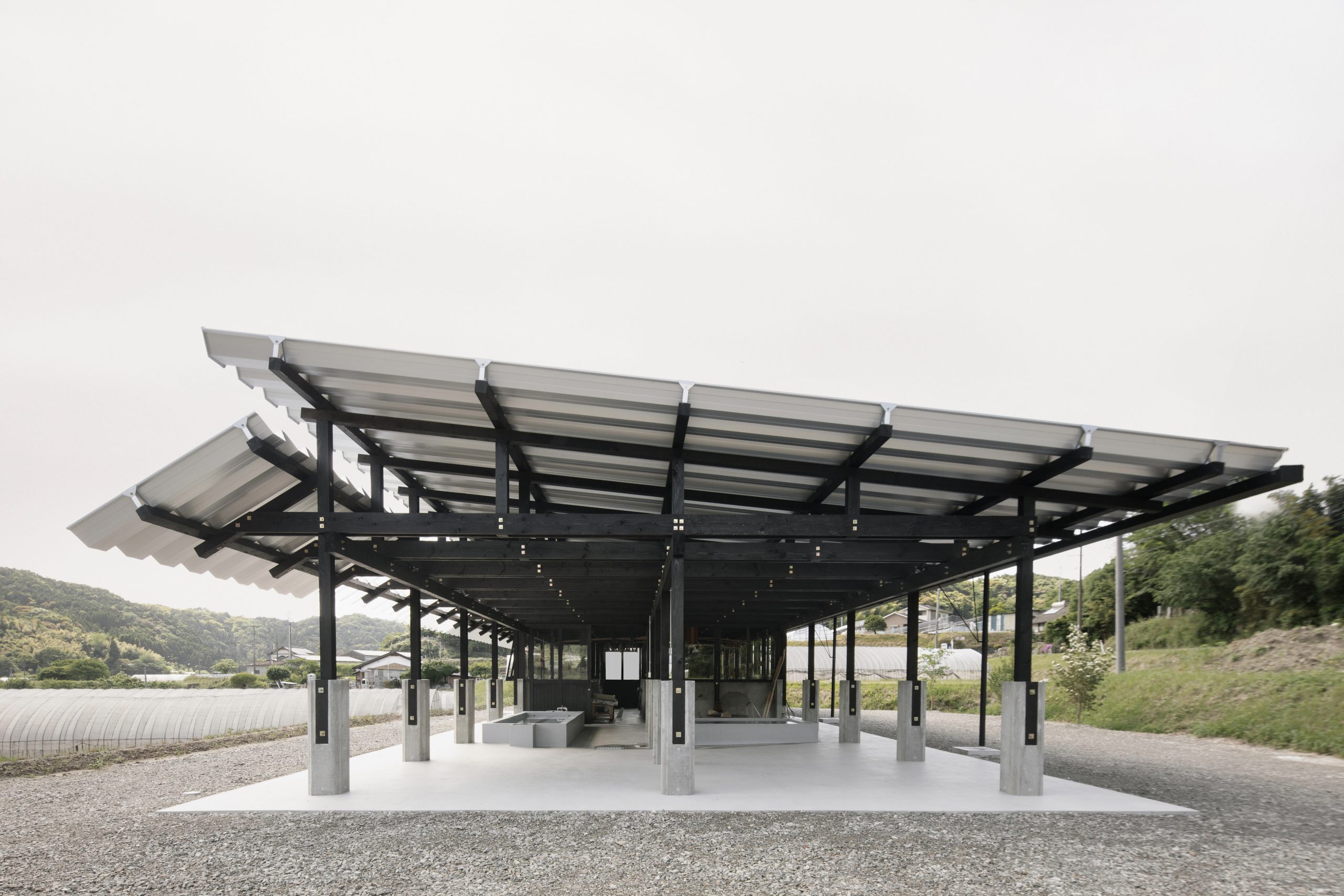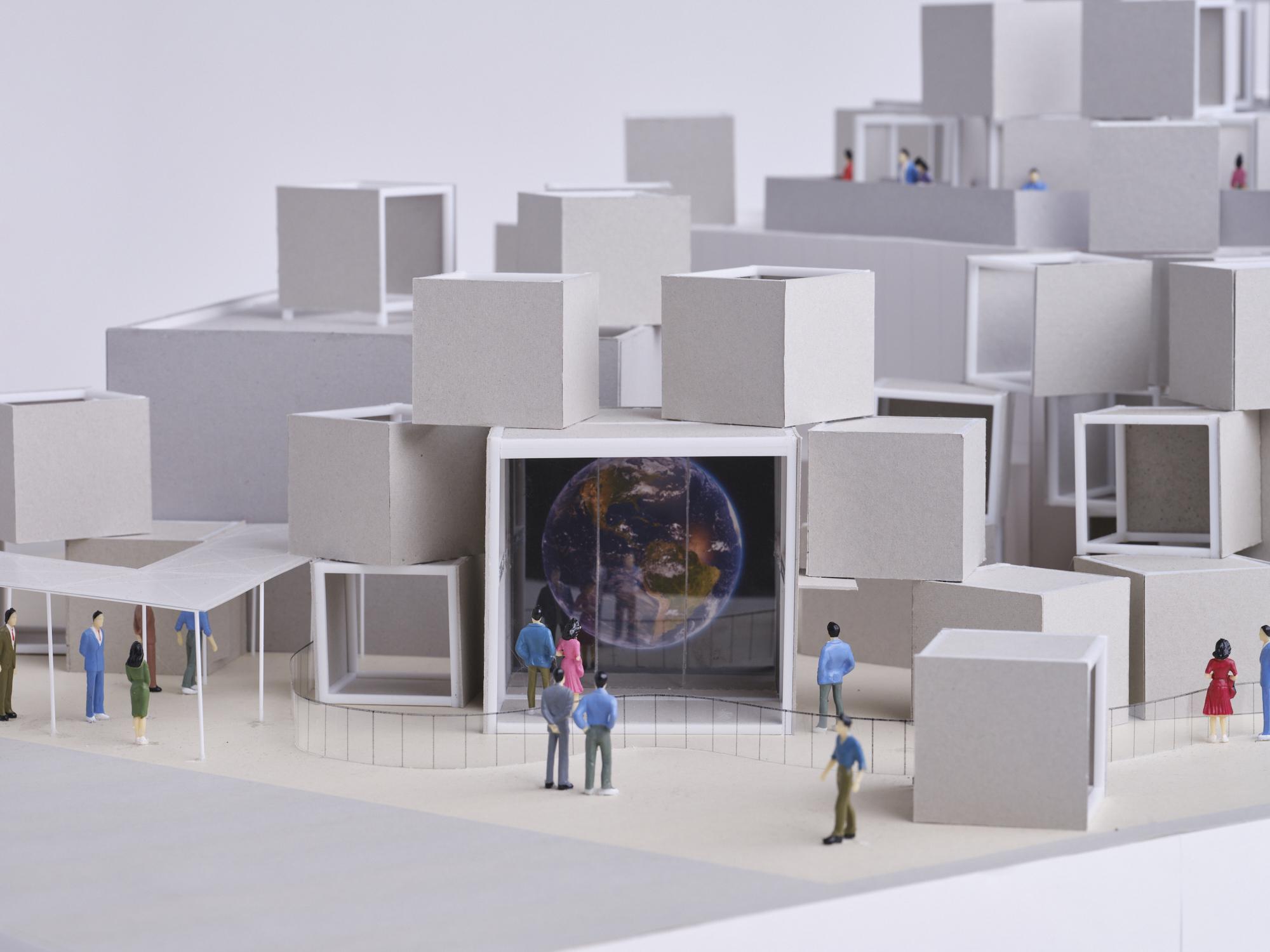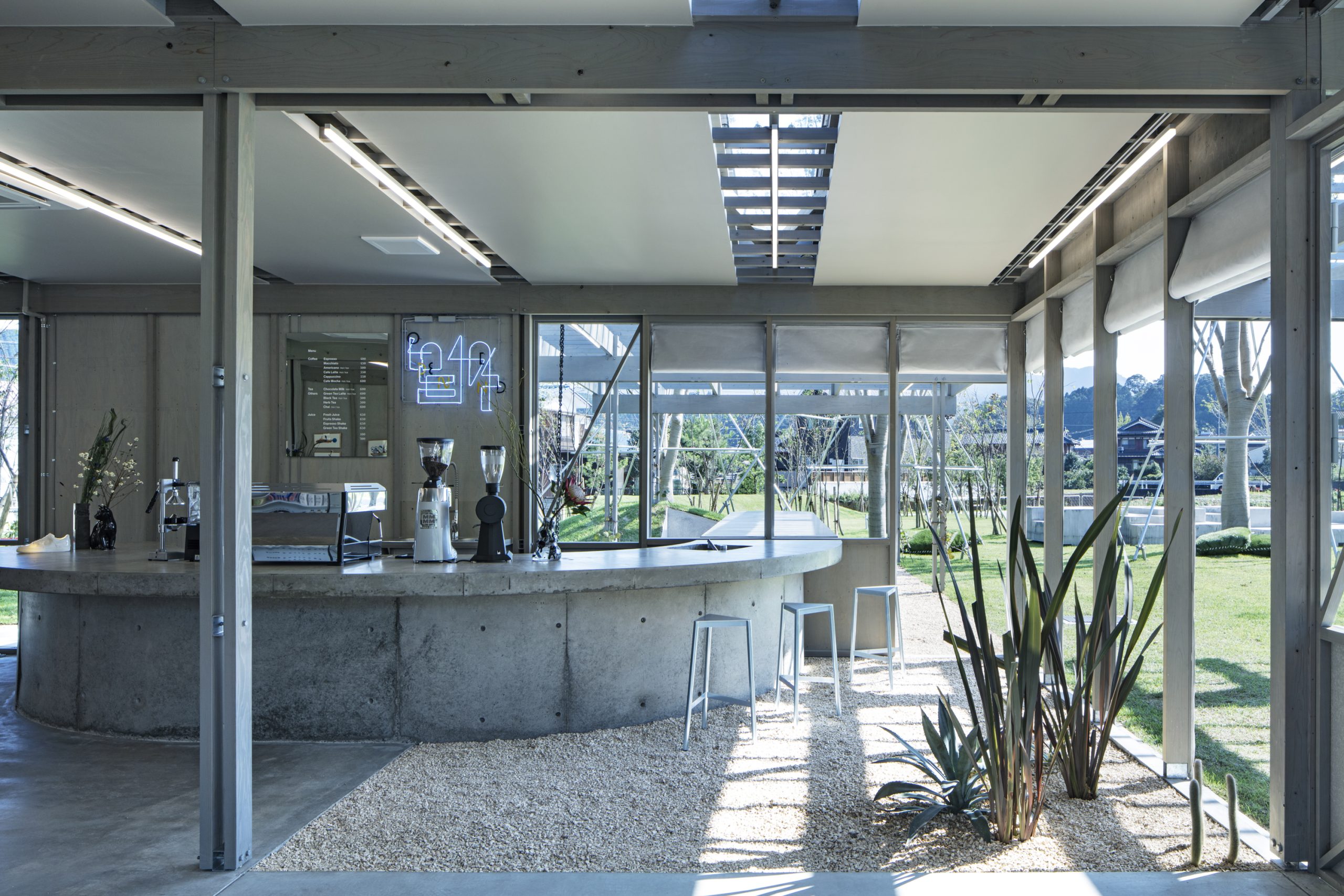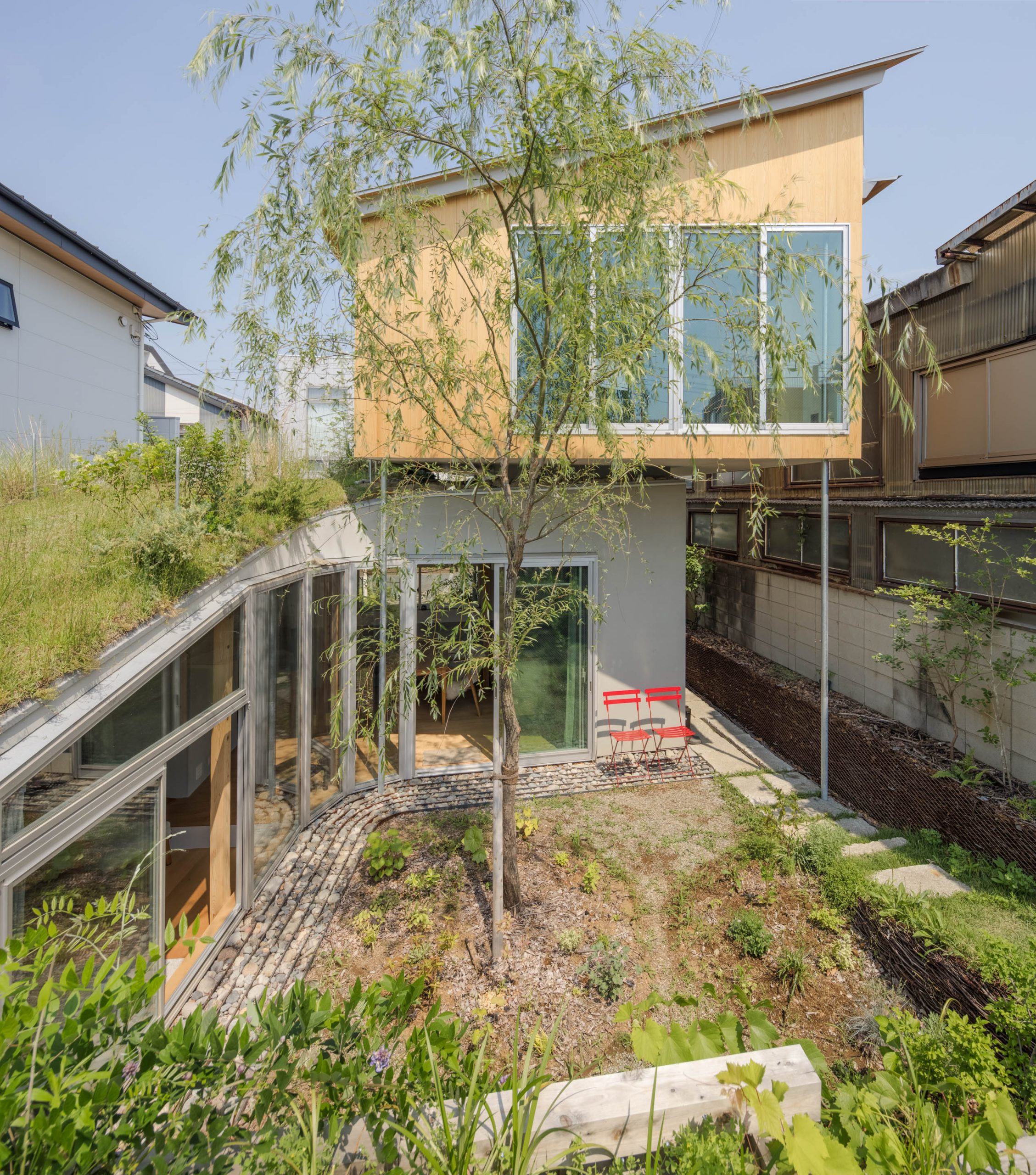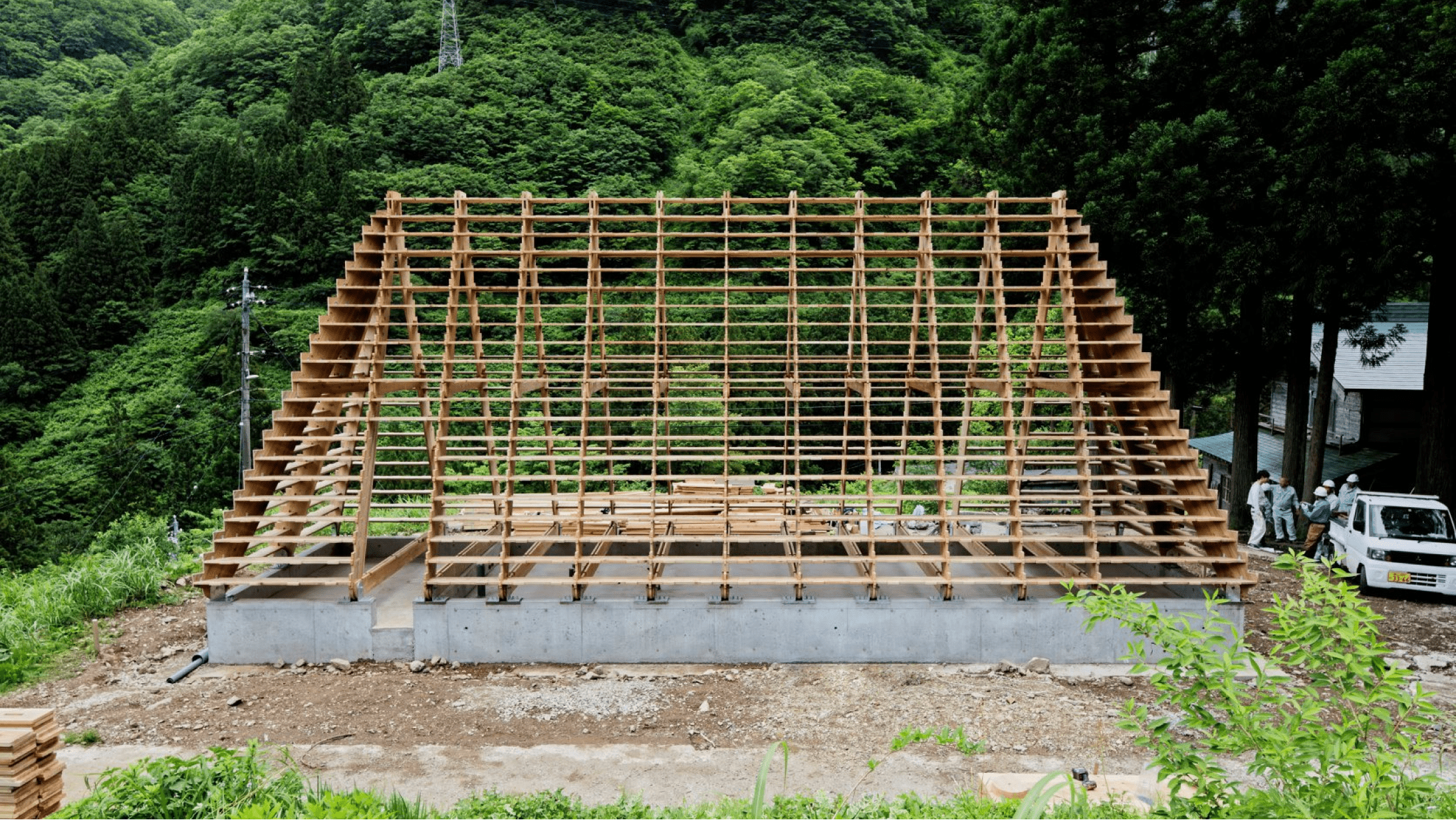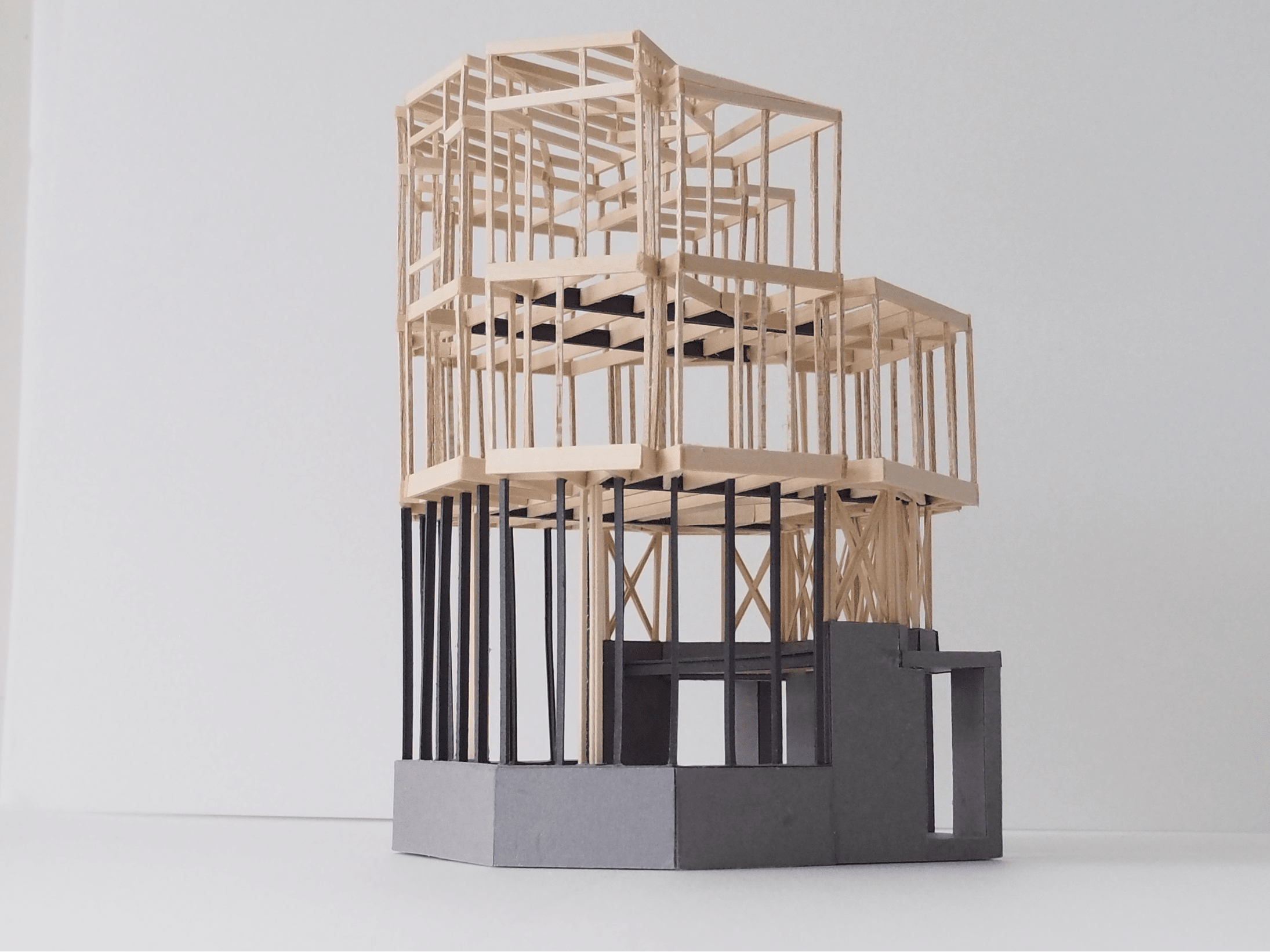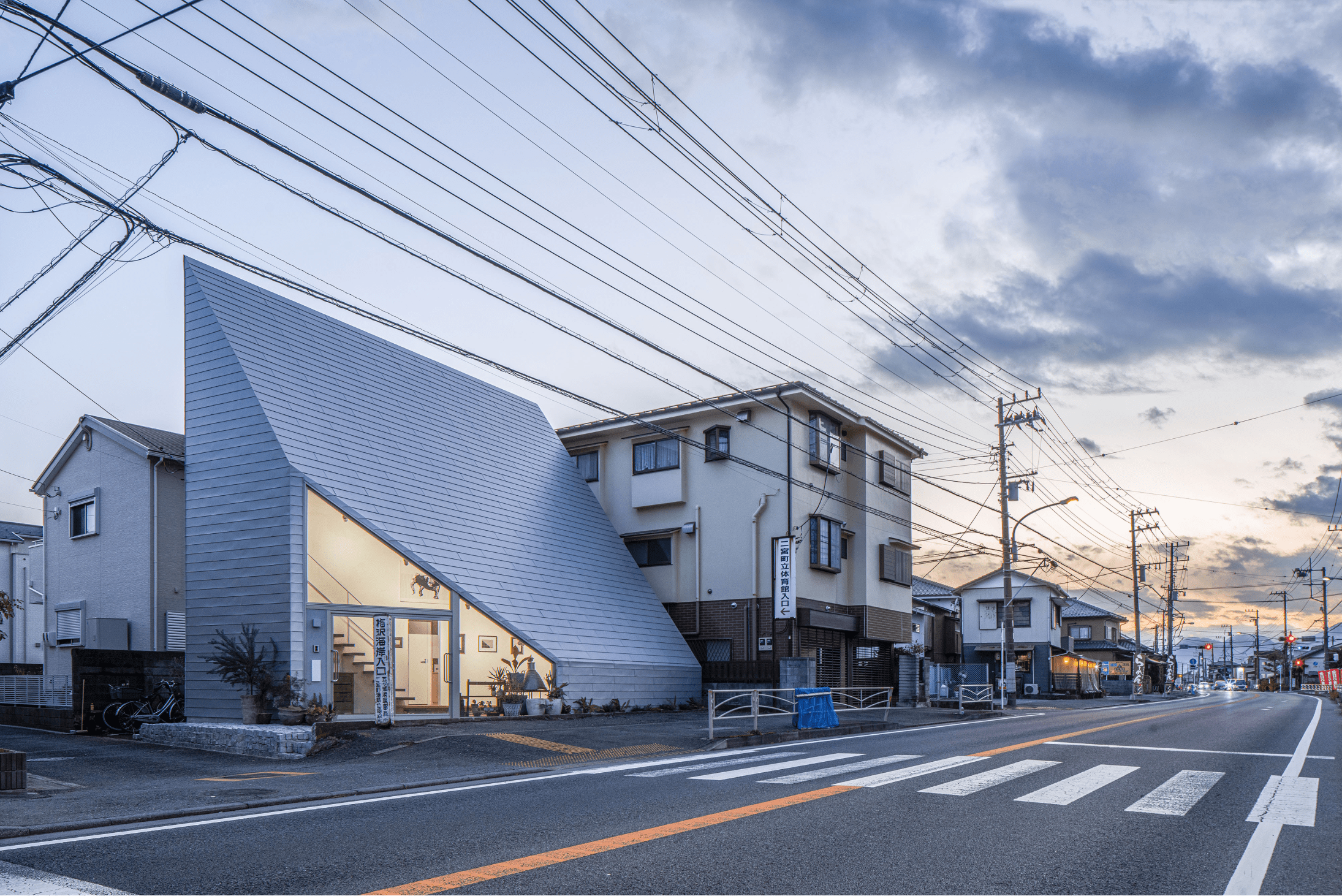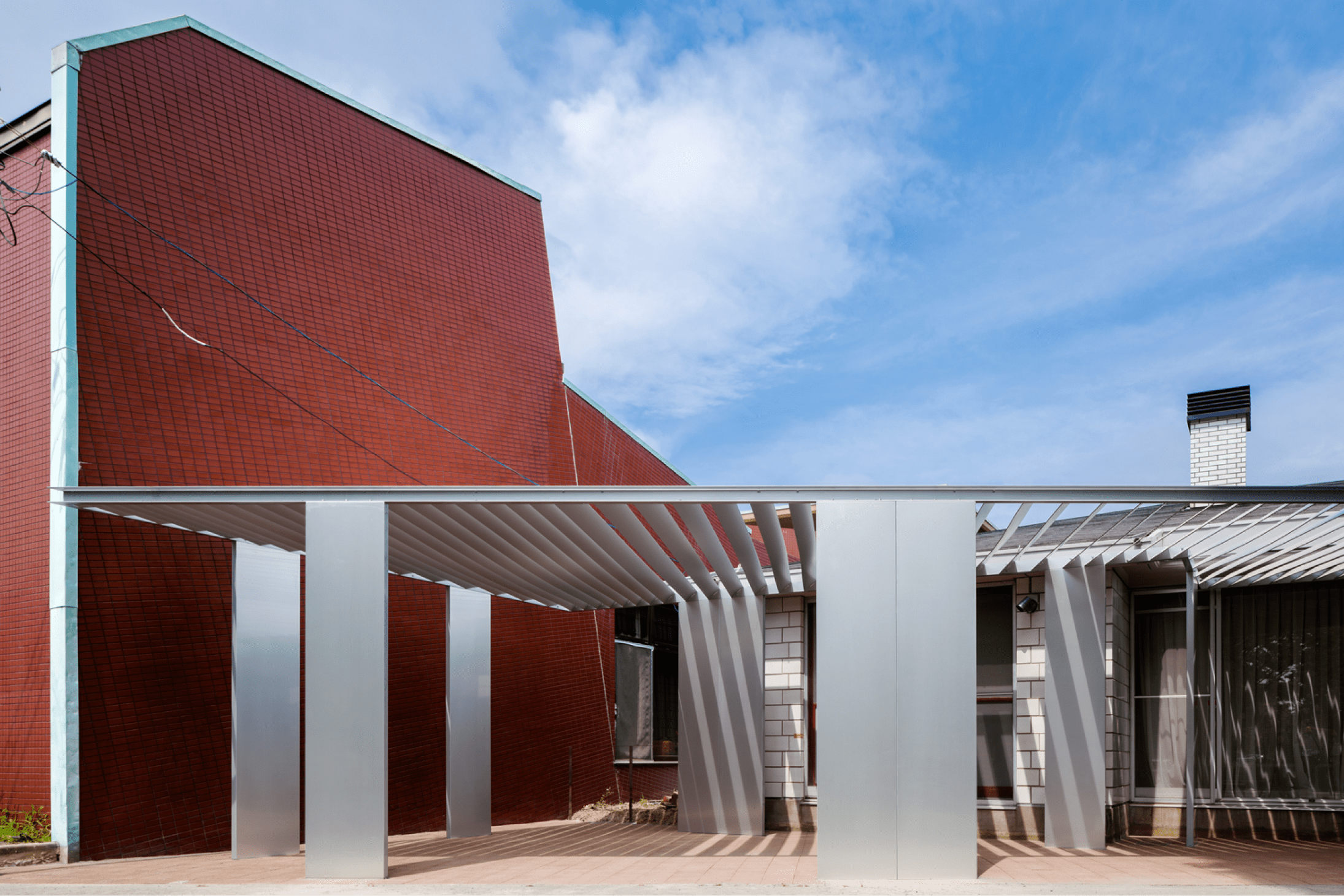OGAWA HOUSE
YEAR 2023
ARCHITECT OFFICE OF NOBUHIRO KITAZAWA
LOCATION TOKYO, JAPAN
PHOTO KEN'ICHI SUZUKI
MORE PICTURES
A three-story private house is located in a dense area in suburb Tokyo. The structure is a bracing system. In general, amount of seismic load and axial force on each floor becomes smaller as it goes to the upper floors. We've focused on a vertical spatial experience by optimizing and visualising of those structural elements.
Based on the theme of the vertical spatial experience, the weight/ size of the optimised structure creates a sense of floating on the upper floors and a sense of stability on the lower floors.
The surrounding environment that can be seen through the openings on each floor become lighter as the reising movement as well. On the top floor, you can see the sky and a distant view of Tokyo.
CIRCULARITY HOUSE
YEAR 2023
ARCHITECT TAKAAKI FUJI + YUKO FUJI ARCHITECTURE /AREANO
LOCATION KANAGATA, JAPAN
PHOTO TAKUYA SEKI
MORE PICTURES
The current timber construction techniques and technicians in Japan are no longer the same as earlier. Unfortunately, our traditional carpenters were replaced by assemblers, due to pursuing the speed and economy of manufacture. They can't make traditional Japanese wooden joinery by chisel and planer like before. From that context, in the project, we used general lumber at a reasonable price, and they were just cut and drilled to make holes for bolting. We avoided having any connection details which needed machine or complicated techniques. All the elements are connected alongside to be tightened by bolts from the side, instead of being on the same line which is required to use special steel plate or joint processing. In addition, those elements are replaceable in the future in case there is an aging damage or critical crack. We aimed to design a long life building from a construction system.
GLASS HOUSE IN PENG CHAU
YEAR 2023
ARCHITECT JHL LAB
LOCATION PENG CHAU, HONG KONG
PHOTO TYPICALPLAN
MORE PICTURES
We got a very rare opportunity such as designing a private house in Hong Kong, where most people are living in super dense apartments. The three-story pensile house is in Peng Chau Island, the site is in a very dense area just under a mountain. The main theme of the architecture is to cover it with a glass wall to get enough light into the living space. Therefore, it was demanded not to have the structure on the outline of the building and to have minimum structure in the room. We proposed the structure which is composed of 6 pairs of ''150 mm thin columns and beams'' added partially by a wall. As a concrete column, 150mm thickness is minimum to transfer the bending moment with general rebar arrangement and structural function effectively works.
NAO WASHI PAPER MILL
YEAR 2023
ARCHITECT STUDIO HASHIMURA
LOCATION SAGA,JAPAN
PHOTO BEN HOSKING MORE PICTURES
YEAR 2023
ARCHITECT STUDIO HASHIMURA
LOCATION SAGA,JAPAN
PHOTO BEN HOSKING
MORE PICTURES
The handmade washi paper mill that has operated for more than 300 years in the mountains of Nao, Saga Prefecture, has decided to relocate to a flat field at the foot of the mountains to avoid the risk of a recurrence of the landslides that have struck the area in recent years. Structural system is referred from our project HIROPPA (2021), however, reversed the relationship of column and beam. 12x 12cm dimension columns are laid out on grid and beams are attached on the alongside of column for Nao Washi Paper Mill. To make a rigid column base to resist to horizontal force such as wind and earthquake, Columns are bolted on the alongside of concrete wall/ column. So then, we could avoid putting any bracings or walls.
2025 EXPO Osaka Signature Pavilion
YEAR 2025
ARCHITECT Office Shogo Onodera
LOCATION OSAKA, JAPAN
PHOTO Office Shogo Onodera
MORE PICTURES
We are designing the structure for the EXPO 2025 with Office Shogo Onodera. The Structure is composed by using an existing container production line. The site of Yume-Shima has a terminal of container tankers, so we suggested using that special opportunity and reasonable idea for the transportation to reduce the energy. The structure is planned to reuse for other site, therefore, the connection details are designed to be able to re-assemble easily.
HIROPPA
YEAR 2021
ARCHITECT DDAA
LOCATION NAGASAKI, JAPAN
PHOTO KENTA HASEGAWA
MORE PICTURES
The architecture is located in Hasami city which is famous for ceramic production in Nagasaki, Japan. The client MARUHIRO is one of the ceramic companies in the city, they planned to make a shop called Kiosk to sell their products in the park with a playground and toilet. We design the structure as simple as possible and to be able to be made by even amature people, which is like DIY.
Simply used general lumber at a reasonable price and they were just cut and drilled to make holes for bolting. We avoided having any connection details which needed machine or complicated techniques. All the elements are connected alongside to be tightened by bolts from the side, instead of being on the same line which is required to use special steel plate or joint processing. The assembly of the structure used only step ladders instead of using a crane or any machine, which was quite unusual for ordinary construction sites, and the worker carried the element by a single person. In addition, those elements are replaceable in the future in case there is an aging damage or critical crack. We aimed to design a long life building from a construction system.
A Villa in Townscape
YEAR 2020
ARCHITECT OFFICE OF NOBUHIRO KITAZAWA
LOCATION SAITAMA, JAPAN
PHOTO KEN'ICHI SUZUKI
MORE PICTURES
A two-story satellite villa is composed of a curved living space with a bathroom/washroom volume along it, and a trapezoidal piano room sitting above it. Those individual spaces behave independently but also are dependent on each other as structural meaning. Particularly, all the seismic force in the piano room is transmitted to the living space below, however, the protruding section is supported with four legs of steel post columns gracefully.
O project
YEAR 2021
ARCHITECT TAKAHIRO MIYAGISHIMA
LOCATION HOKKAIDO, JAPAN
PHOTO Daici Ano
MORE PICTURES
We designed the existing old house as a renovation as a bookshop and home and an annex as a new building for the kitchen of the cafe. The existing house was reinforced with walls to follow current regulations, some original beams and columns were removed, and new structural elements were added. The annex volume consists of 2 concrete columns and tensile columns to support the concrete slab and resist horizontal forces.
NISHIJI PROJECT
YEAR 2021
ARCHITECT MAI KOMURO/ KOMPAS
LOCATION CHIBA, JAPAN
PHOTO Vincent Hecht
MORE PICTURES
The gallery and house are in Chiba, Japan. We adopted the so-called Vierendeel truss system with timber structure to minimize dimensions of the structural elements to span max 8.2m. This system doesn't block the visual line and light from high side windows. Ground floor consists of a concrete structure.
Concrete and timber walls are mixed on the 1st floor; however, concrete walls are non-structure, and it is confirmed that timber structure is satisfied to have enough strength against seismic/ typhoon load. The solution was to avoid being required to do complicated calculations with a mixed structural system on the same floor by Japanese building code.
HIROSAKI ART MUSEUM AND RESTAURANT & SHOP BUILDING
YEAR 2020
ARCHITECT ATELIER TSUYOSHI TANE ARCHITECTS
MUSEUM STRUCTURE DESIGN: OBASYASHI CORPORATION + STARTS CAM
RESTAURANT & SHOP STRUCTURE DESIGN: yasuhirokaneda STRUCTURE + STARTS CAM
LOCATION AOMORI , JAPAN
PHOTO Daici Ano
MORE PICTURES
The museum is in the northern part of Japan, Hirosaki city in Aomori prefecture. We were an adviser as a team of ATTA for the museum building and designed the structure of the restaurant and shop building mainly. The original buildings were brick warehouses for the first cider factory in Japan.
The structural engineer in Obayashi corporation proposed reinforcement of the brick walls to satisfy the strength required by the current design regulation, therefore, we could use the original structure. On the other hand, the original structure where the restaurant and shop building are located now was an old timber structure, however, the existing beams and columns were so damaged and plenty of corrosion wood. It wasn't realistic to renovate from the original. We decided to keep the facade brick wall and build a new structure for the building. We designed the structure to be as slender as possible even though the site is in a heavy snowy area.
ATTA won the AFEX 2021 Grand Prix with the project.
House for Marebito
YEAR 2019
ARCHITECT VUILD
LOCATION TOYAMA, JAPAN
PHOTO HAYATO KUROBE
MORE PICTURES
Tradition x Digital: The first digital fabricated architecture in Japan.
This house is the first digital fabricated architecture in Japan as a permanent building. Through the project, we've tried to combine the Japanese traditional technique of wooden structural joints and digital technology with using machines.
The shape of this architecture is referred from a roof truss of "Gassho-Zukuri '' which is the traditional housing type in this area.
And all the timber material which we used was cut from the forest around the area, and they were processed to the structural elements in the small local timber manufacture factory. The factory used the shop-bot which was provided by VUILD. Along the latitudinal direction, the truss, which is composed of the "Gassho-Ita"(30×430mm) tilted at 70 degrees and arrayed on every 1m resists horizontal force.
Due to the limitation of the material length, ''Tie-beam'' also works as the connection piece for joints of Gasshou-boards. Along the longitudinal direction, the structure is planned by the stiffness of "Nuki-Ita" (flat use) and '' Waku-Ita'' (vertical use). The '' Nuki- Ita'' (flat use) is effective against the out-of-plane wind pressure, and at the same time, it has the function as a buckling stop of the thin Gassho-board (30mm).
The joint of the '' Gassho-Ita '' is stopped to rotate using four drift pins, and the end of the processed tie-beam is inserted from the side.
A drift pin that has a lot higher shear strength than a timber dowel is used, it works for minimizing the lack of cross-section of the Gassho-board and secures as much effective range of the inside space as possible by making the height of the beam small. On the top of the Gassho-board, a board is added simply and tied with drift pins.
The '' Nuki-Ita'' connected from right to left of the Gassho-boards is used as a finger joint via '' Gassho Ita'' and tightened with some timber dowels such as Japanese traditional joint system.
The mortise processed frame plate is inserted to each Gassho-boards and construction lumber from its side, resisting the axial rotational rigidity against the Longitudinal horizontal force.
Normally the out-of-plane direction of the frame plate tends to expose to negative wind pressure, however, the area (width 2000× length 1000mm) and also the pulling force are not that large, therefore we used not screws but seven N90 nails every span to resist the pulling force and anti-slip.
This project was chosen as the GOOD DESIGN award 2020 gold award winner.
NOMURA PAVILLION
YEAR 2019
ARCHITECT VUILD ARCHITECTS
LOCATION KANAGAWA, JAPAN
PHOTO HAYATO KUROBE
MORE PICTURES
The temporary structure was designed within 2 weeks and fabricated, assembled in another 2 weeks. Computational design and digital fabrication are surprisingly able to reduce time more than the traditional way of designing and producing. VUILD ARCHITECTS is a Japan based architectural design and construction company, we have been collaborating on many of their projects. The pavilion is composed of Hexagon frames and triangle pieces of 12mm laminated board and we invented the asterisk connection piece which could solve the complicated and important node. The structure has very simple details but enough stiffness and strength.
A HOUSE IN HOZUMI
YEAR 2022
ARCHITECT NAOYA KITAMURA ARCHITECTS AND PLANNERS
LOCATION AICHI, JAPAN
PHOTO TOMOYUKI KUSUNOKI
MORE PICTURES
The temporary structure was designed within 2 weeks and fabricated, assembled in another 2 weeks. Computational design and digital fabrication are surprisingly able to reduce time more than the traditional way of designing and producing. VUILD ARCHITECTS is a Japan based architectural design and construction company, we have been collaborating on many of their projects. The pavilion is composed of Hexagon frames and triangle pieces of 12mm laminated board and we invented the asterisk connection piece which could solve the complicated and important node. The structure has very simple details but enough stiffness and strength.
KOCA
YEAR 2019
ARCHITECT @KAMATA
LOCATION TOKYO, JAPAN
PHOTO @KAMATA
MORE PICTURES
The project was designing the coworking space and rental space which are located under a railway structure in Tokyo. The loading conditions were limited and strict by the railway company's regulation. We needed to avoid the railway foundation and not exceed the limited load capacity of the ground carefully. We are asked to design the structure as simple as possible to achieve easy/ quick construction and basically a low cost one. We suggested using a container for small spaces and a simple structural sistem with less columns for other big spaces.
PANORAMA HOUSE
YEAR 2020
ARCHITECT Mosaic Design Inc
LOCATION KANAGAWA, JAPAN
PHOTO KASUTAKA FUJIMOTO
MORE PICTURES
In this house, each floor has each language of structure. On the ground floor, triangle formed concrete columns stand quietly. On the 1st floor, concrete walls are located on the plan tidily, for both the outer wall and boundary wall. On the 2nd floor, the wooden structure gives a bright and light feeling, even though there are cantilever volumes. The design would make the house a fascinating discontinuity in section.
YEAR 2018
ARCHITECT TSUYOSHI TANE/ATTA
LOCATION TOKYO, JAPAN
MORE PICTURES
How should the structure consist ?
The structure of the architecture consists of hybrid material such as timber, steel and concrete. We've carefully chosen the material of structure and where to use them, based on structural reasonability. The back side of the basement was needed to resist soil pressure and to have a water-proof spec, therefore, it was chosen concrete.
In order to resist the seismic load, we needed walls or steel braces on the transparent facade side, since we don't prefer the visible bracing system, we chose two walls but they should have been preferred as thin as possible. We set in front of the facade minimum length and minimum thickness which was required in the building standard symmetrically.
Eventually, they became a great eye-stop between the interior space and the green in the garden which is designed by the gardener client.
In order to avoid putting columns on the upper floors, we used steel I - beams efficiently for primary beams to minimize the thickness of the floor. A rest of beams consit by construction pine-lumber.
YEAR 2019
ARCHITECT DOG
LOCATION KANAGAWA, JAPAN
PHOTO SATOSHI TAKAE
MORE PICTURES
The structure consists of 105mm square materials without a hierarchy of thickness.
In this project, we planned the structure to use a total floor area of 87.23 ㎡ effectively, including the required functions; a gallery, and a multi-generational house.
Firstly, the roof, the floor, and the walls are made using 105mm pine wood. On the vertical side, we adopted a 12mm structural plywood as double side panels adhered to the column and beam using glue to solve the weakness problem of the high floor and the wide span.
The "Roof wall" which receives a load from out-of-plane direction under long-term loading has one 125 ×125mm steel beam on the direction perpendicular to the ”Diagonal wall”, and its stiffness is evaluated as a wide flange column in case of the Typhoon. By doing this, the thickness of most of the walls is planned 129mm that is the same as the beam’s including structural plywood, therefore, the space in this structure was uniform in case of thickness. The ”Diagonal wall” dividing the house into north and south plan which has the role of an exhibition wall of the gallery can satisfy the requirements of longitudinal wall quantity after the resolution of a vector and structurally has high stiffness in terms of the calculation of the fourth division method. In this project, we could propose a new possibility, to secure the big volume inside consisting of thin roofs and floors as the walls, rather than not getting caught up with the idea that floors and roofs are normally thicker than walls.
YEAR 2013
ARCHITECT YUSUKE OMURO/ atelier
Ichiku
LOCATION CHIBA, JAPAN
PHOTO hayato wakabayashi
MORE PICTURES
Served and Servant Structure
The architecture is a photo studio located in a beach side town Kujukuri- hama in Chiba prefecture, composed of a large space for photo shooting called ''served space'' and a small space for facilities such as a bathroom, make-up space and changing room where they called ''servant space''. We followed the composition for designing the structure, and were conscious of the relationship between the large one and the small one. The large one has the lack of stability for resisting seismic load/ wind force and thrust stress caused by long spans. We took this fact positively and made the small space stiffer/ stronger to be able to support the big one.
YEAR 2015 - 2019
ARCHITECT YUSUKE OMURO/ atelier
Ichiku
LOCATION JAPAN
PHOTO hayato wakabayashi
MORE PICTURES OF HAUS 004
MORE PICTURES OF HAUS 006
MORE PICTURES OF HAUS 007
MORE PICTURES OF HAUS 008
An ordinary structure but being kept symmetrical and organized.
Working with architect Yuske Omuro is quite unique for us. His projects have ‘’tension’’ in the spaces. He is a well known architect who uses the orders such as golden ratio or silver ratio in his design. We collaborated with him for Haus 001, 004, 006, 007 and 008.
Haus 004 wasn’t an exception for him, an unique point of the project was to design a ready-built house instead of designing for a specific client. Since it was a ready-built house, the budget was quite low. Therefore, he needed to use low-cost standard materials for finishing which are used for ordinary houses, which are generally not used for so-called design houses. However, it wasn't a negative condition for him, it doesn't matter how much the materials cost, but he cares cautiously about how all the elements proportionally relate in his design. You would feel that from the completed architectural space. Our structure just followed his rules.
You can see his other great works from his website too.
YEAR 2019
ARCHITECT KITAMURA NAOYA
ARCHITECTS AND PLANNERS
LOCATION GIFU, JAPAN
PHOTO Shinkenchiku-sha
MORE PICTURES
A forest of slender columns
In this project, it was first planned from a small 1.82m grid plan, and we thought it is important to include the structural elements as thin as possible from below for two reasons.
Firstly, we thought that high ceilings such as 3.3m, which are beyond normal height and cover the wide area of this house, can be a big characteristic in Japanese modern houses.
Additionally, the thickness of the columns was planned to be less than 105mm to express "the unmeasurable condition from the experience" as the purpose of this design plan, rather than using a thicker column than 105mm square.
Secondly, the aim was to achieve building an abstract, elegant, and balanced volume, which still has columns arranged finely, by planning the cross section of columns and beams using the same thickness, and a 90mm square column, which can be used as a minimum dimension of widely available lumbers.
In the earthquake resistance plan, only the outer walls are treated as the structural wall, and the inner walls can be treated as a weak structure, therefore people can impressively recognize the inside of the house as one volume. The floor and roof located on the outer side are effective against the wind pressure measures, also they are the rational plan to integrate the elements of the design and the structure.
YEAR 2018
ARCHITECT ft+ fumiko takahama architects
LOCATION KANAGAWA, JAPAN
MORE PICTURES
The fictionality- in the architectural design
The grid roof exaggeratedly exposed to the outside is continued inside as the same system. inside, the slimmer steel columns are used than outside, giving people the experience of the different sequence.
However, in fact, this grid roof and steel columns don't continue to the hidden wall and roof on the west side, but it consists of just a combination of wood columns and beams which array reasonably and orderly.
In this project, we adopted "The fictionality" which is required on the things between experience and support in the architectural design.
Normally, the structure is not exposed to outside all the time; therefore, I expect it also has another possibility that completes a story that a designer wants to express.
YEAR 2020
ARCHITECT VUILD
LOCATION JAPAN
PHOTO HAYATO KUROBE
MORE PICTURES
Collective structural elements
The acorn-shaped hut is a camping unit. All the material was processed by a CNC machine, so called digital fabrication.
The structure simply consists of a back plate and two rib-plates, they are all made of 24mm structural plywood which is the standard spec in the market in Japan. The Japanese clog-shaped unit. They are stacked in 5 layers, fastenned the upper and lower rib plates with two bolts.
As a result, they are able to be evaluated as continuous columns and are a structural system that resists bending moment caused by the long term load and also the horizontal forces such as Typhoon and Earthquake. The back plate acts as a buckling prevention in the thickness direction of the thin rib plate ( meant columns), at the same time, and a role of increasing the horizontal rigidity in the surface. Since the project meant to make an alternative idea of a tent, we've aimed for a structure which can be created in a simple and primitive language while being aware of temporariness and simple details to achieve to assemble easily.
YEAR 2016
ARCHITECT TSUYOSHI TANE
LOCATION KANAGAWA, JAPAN
MORE PICTURES
The house is located in Kanagawa, Japan. A bedroom volume stands on four independent volumes. The composition is quite simple but the structural system was tricky, especially to design the way of resisting horizontal force and transmitting those forces to each other.
In addition, the top bedroom volume doesn't have any walls on the windows side, therefore, the long wall located on the other side needs to resist horizontal forces in a longitudinal direction.
YEAR 2020
ARCHITECT 403 architecture [dajiba]
LOCATION HIROSHIMA, JAPAN
PHOTO KENTA HASEGAWA
MORE PICTURES
The optimization of respective structural elements carefully.
The architecture has a very simple and unique program as seats for the cat café.
The whole structure is suspended by the roof, composed with Hinoki timber and steel standard profiles which include a square shape and a flat plate. The structure has been very carefully designed and optimized those structural elements by depending on what kind of forces to support/ resist.
YEAR 2017
ARCHITECT RAAW studio
LOCATION HONG KONG
MORE PICTURES
The pavilion was a temporary playground located in Yuen long, Hong Kong. The requirement of the structure was as simple/ slender as possible. The structure consists of 50mm diameter steel columns and 50 x 20mm rectangular section ring- shaped beams.
The columns and the ring-shaped beams are connected by bolts, this atypical framed system achieved to resist horizontal forces such as Typhoon.
The base of the columns selected an improved sleeve joint to make the assemble and disassemble easier.
YEAR 2020
ARCHITECT Matias Zegers Arquitectos
LOCATION EASTER ISLAND, CHILE
PHOTO Matias Zegers Arquitectos
MORE PICTURES
The limitation of the material changed the composition of the architecture.
The house is located on Easter Island, 3500 km away from the mainland Chile. The island is most famous for its nearly 1,000 extant monumental statues, called moai.
The difficulty and unique point of the project was limitation of the materials which we could choose for the structure. Due to the location being isolated, the construction materials we could use were limited than general projects.
We simplified the structural elements as much as possible.
The roof consists simply of a CLT panel 70mm which is in circulation for the general house constructions in this island, the shape looks triangular just like a standing book open. We also use the CLT panel 120mm for the timber bearing walls. And the rest of the structure was used for construction lumber such as the double ridge poles, tie-beams and columns.
In addition, we use the soils from the ground which is beautiful red to mix the concrete for the bearing walls.
YEAR 2019
ARCHITECT TAKAHITO MIYAGISHIMA ARCHITECTS
LOCATION HOKKAIDO, JAPAN
MORE PICTURES
''mezzo piano'' and ''mezzo forte'' in our structure design.
The 6m long columns located in the entrance hall are required to resist wind pressure out-of-plane direction. We expressed the visualization of the force of resistance that the outer wall receives, by planning the columns a bit thicker than the minimum required cross-section and setting it outer of the finished wall.
We put many thin walls as a "non-structural wall" which supports no horizontal force such as an earthquake.
It is composed of base materials of 30mm thickness columns that are extremely thinner than general use 100 mm for ''non structural wall'' and are used as the minimum dimension to stand on itself. It expresses its fragility as a characteristic of a non-structural wall.
By expressing the contrast between the above‐mentioned forceful columns and fragile walls strongly, we establish connections between the structural elements in one space and achieve a relative structural design.
Through the project, we tried to express the force which a structure receives as the design, by generating the contrast of the relative composition of ''mezzo piano'' and ''mezzo forte''.
This is one of the important themes for our structure design.
YEAR 2013
ARCHITECT ARCO ARCHITECTS
LOCATION IBARAKI, JAPAN
PHOTO IPPEI SHINZAWA
MORE PICTURES
The light aluminum walls
The wall panel consists of 50 x 3 aluminum squares columns, and 2 mm structural aluminum plate is welded, and then covered with a 2mm finishing aluminum plate which is bent into a U-shape. The panel size is 450mm width and 3m heights. They were brought to the site as a panel which was pre-assemble in the factory to reduce the construction time on site.
In addition, the roof louvers consist of aluminum flat plates were welded to both ends and unitized to 1 m width at the factory. This panelizing and unitizing achieved a size and weight that can be carried by a craftsman alone, it was possible to complete the construction in a single day with only a stepladder without scaffolding. Aluminum panels required ''alumite treatment'' to prevent rust, but the general method eliminates the nice reflection which a pure aluminum plate has, therefore, we solved the remaining reflection by shortening the treatment time and reducing the penetration thickness.
YEAR 2015
ARCHITECT LAAB
LOCATION HONG KONG
PHOTO LAAB
MORE PICTURES
Swing structure
The first project was completed in Hong Kong in 2015.
A pavilion consists of some large swings with different directions.
The first image which the architect LAAB shared with me was the roof was supported by many very slender columns. It was very beautiful. However, since the vibration comes from movements of swinging differently when there are many people used, we needed to have a solution to resist the force.
And, instead of making those columns thick, we suggested a totally different structural system called the '' SWING STRUCTURE''.
The structure basically consists of leaning columns to resist the horizontal forces caused by the people's swinging movements.
It looks like leaning diagonally and doing ''swing dance'' from the 1930s.
This is a renovation project for an old Japanese house which has been renovated 3 times already before we designed the house. We surveyed the house very carefully to grasp how those renovations were done in the past. It has shown many interesting generation schemes and we respect that and referred to those past renovations. We hope that our design will be one of those generations and someone will redesign it in the future by reading the context.
YEAR 2018
ARCHITECT YUSUKE OMURO/ atelier
Ichiku
LOCATION JAPAN
In the architecture, the size of columns, height of beams and size of braces are getting gradually smaller as you go up to the top floor from the ground floor. The wall and floor thicknesses are also getting thinner.We are interested in how we will feel this changing lighter structure based on the floors.
We believe that the wall and floor thicknesses are essential and important information for the space feelings even if that is unconscious. We experimented with the idea through this project.
The realization has shown quite an interesting feeling about the architecture.
YEAR 2018
ARCHITECT I.R.A
LOCATION KANAGAWA, JAPAN
MORE PICTURES
Re-set architectural language
Attempt to deviate the general definition
In Japan, the minimum offset distance from the external wall to site boundary is set as 1.5m or 1m in general by the Building Regulation, therefore, external walls are somewhat forced to be built further inside from the site boundary line. On top of that, block walls or fences are built to physically visualize the site boundary, which does protect your privacy, therefore, it is important in an urban city.
For this project, 2.1m height block wall stands on top of the site boundary line and secures privacy of the tenant. Meanwhile, the naked columns appear as the renown “external wall” is taken off. This way, it maximizes the internal space and compliments the openness of the space made.The first thing I tried was to imagine the external wall to be torn off and columns to be exposed and become somewhat like a subframe of the wall. Architects would say, "you can design to follow the structural reliability since columns would be hidden by the finishing". Therefore, in a way, I thought it would be interesting to expose this part of the element. Bulky block wall that withholds the strength shifts out to the boundary line and leaves the weakened “external elements” including naked steel columns.
'' .....Since there were shoe wall-cabinet and toilet wall in the architectural drawing, I decided to let them bear the lateral force. Their original thickness was 64mm and if it was to be thinner than that, they would be able to retain to act as a ’non-structural wall’. Thus, I designed the wall composed of 50mm pipe and 3.2mm steel thin plate welded sandwich with a total thickness of 56.4mm and redefined the purpose of bearing wall and non-bearing wall''.
The structure of the external wall abandoned its structural responsibility of bearing lateral force, thus, the thin non-structural wall undertook to do it instead.Structural elements such as structure itself, frame, finishing, external wall, furniture and non-structural walls have each distinctive responsibility. What is interesting is to see the outcome of shuffling around general structural responsibilities of each structural element. In fact, the idea of “non-structural wall bearing lateral load” does not make sense.For this structural planning, it plays around with the general hierarchy of the structural elements and attempts to deviate from the so-called skeleton / sub-structure / finishing characters.
YEAR 2017
ARCHITECT DOG and ARCO
LOCATION MIYAGI, JAPAN
PHOTO Ippei Shinzawa
MORE PICTURES
‘Core’ is the focal point for the Pyramid in Kamiida. The central volume is composed of a living room, dining room, bedroom and rooftop terrace. Both the core purpose of the house and the structural core are centrally located. In most cases, the structural core would be located based upon locations of stairs, lifts and other hidden spaces which usually are left at the side.
Thus, the usable spaces would be limited, and other function rooms would be scattered around this structural core. However, for this project, all of the core is located in the center which prioritizes the core spaces and the core of the house is physically located in the center. In addition, the circulation space is set around the ‘core’ and a rooftop terrace is located at the end of this space where it serves a phenomenal view.
YEAR 2016
ARTIST OU NING
ARCHITECT THOMAS TSANG AND KAZUHISA MATSUDA/ DEHOW PROJECTS
LOCATION TAIPEI FINE ART MUSEUM( 台北市立美術館)
PHOTO DEHOW PROJECTS
MORE PICTURES
When designing a structure, I tend to think about the scale and unique condition of the project that plays an important role.
Designing exhibition space: Exhibition space already has walls, floors and ceilings (including existing beams and ceiling slab). Moreover, it can be said that the idea of being able to utilize existing walls and ceilings is the same concept of being able to utilize surrounding houses/buildings on a larger architectural scale. If you think it just like that, you’ll realize how unique this project is.
Existing walls: As long as the existing wall bears lateral loads, when it comes to building a structure of a new object or a space, the structure does not need any load bearing system.
Existing ceiling: Being able to use the existing ceiling means that since it would be suspended from above, it is possible to construct a structure without considering its compressive forces. This means that within the exhibition space, even seismic/gravitational forces can be neglected anywhere in the world. For this project, the existing ceiling wasn’t used so only lateral force was ignored.
The section of structural members:In Japan, 105X105 timber structural members are generally used for beams. However, I had an instinct for knowing that a 105X105 member would not work with this odd project condition. This might’ve been because, as it has been said previously, the site condition was unique and the project was temporary. The idea was to use a 30mm base thickness timber member and after agreeing upon section dimensions, a ‘skeleton’ column was composed by four 30X30 vertical elements and 30X60 horizontal beam elements which created a joint. One of the reasons that led to this joint design was that it was an initial idea that it would be better to conceal the joints where the high-quality fabrication was not secured. Moreover, using smaller timber members enabled us to kill two birds with one stone.
Structurally, four 30X30 vertical elements fulfill the section area of a 60X60 column but are separated. For the 30X60 beam, it runs between 2 30X30 horizontal elements and this continuous beam plays an important role in its displacement and stress, which at the same time prevents buckling within column elements. Thus, I found some possibilities in unique column structure and it would be interesting to play around with different scales as well.
